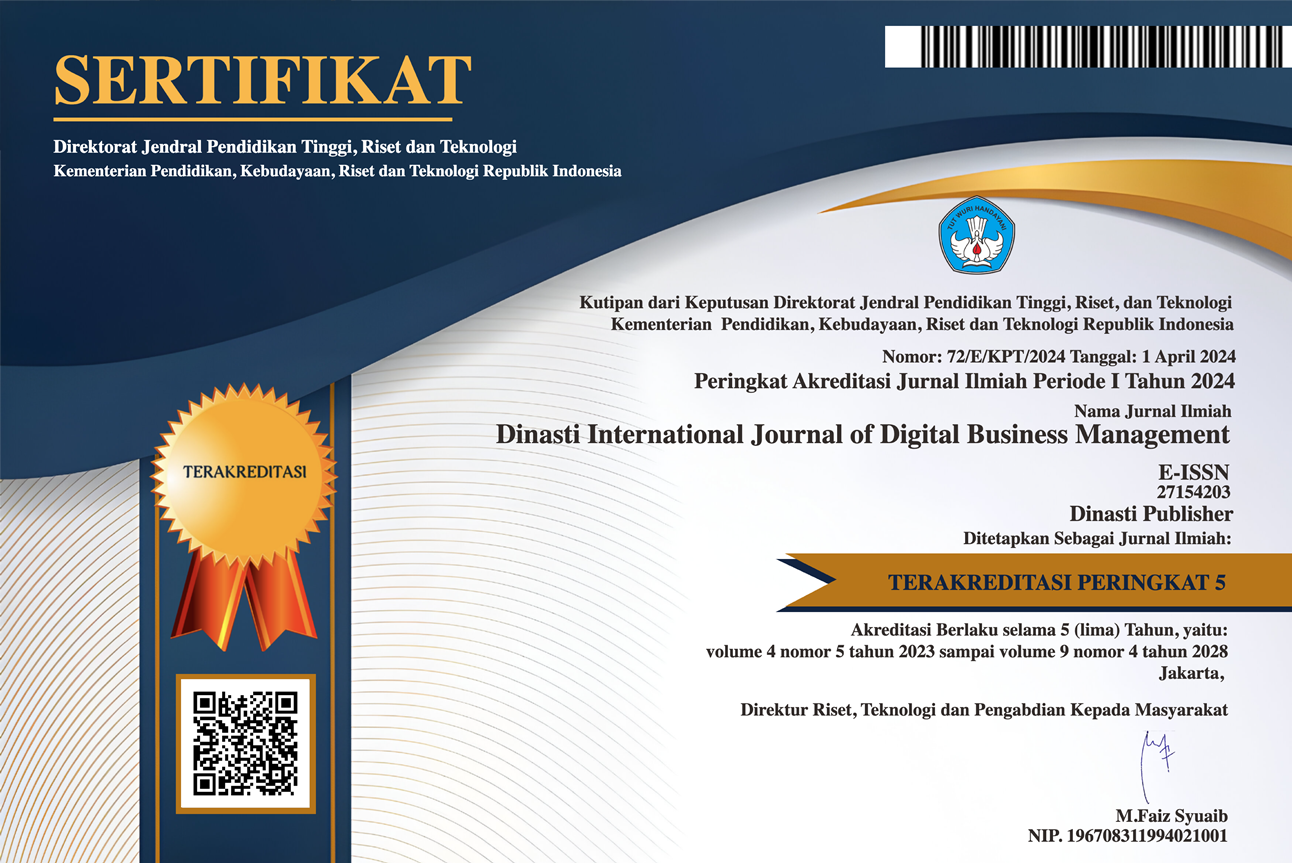The Influence of Leadership and Motivation on Employee Performance (Literature Review MSDM)
DOI:
https://doi.org/10.38035/dijdbm.v6i2.4331Keywords:
Employee performance, leadership, work motivationAbstract
The aim of this research is to develop hypotheses regarding the influence between variables that will be used in future research within the scope of human resource management studies. The writing method used in this research is library research, sourced from previous studies. Online media platforms such as Google Scholar, Publish or Perish, and other academic online media were utilized to obtain previous studies. The results of this research are as follows:1. Leadership influences employee performance; 2. Work motivation influences employee performance.
References
Abdullah, M. (2014). Employee performance management and evaluation. Yogyakarta: Aswaja Pressindo.
Adiyasa, N. I. W., & Windayanti, W. (2019). The influence of motivation, job satisfaction, and leadership on employee performance at PT XYZ. Journal of Strategic Management and Business Applications, 2(1), 23-30.
Anoraga, Pandji. (2003). Psychology of Leadership. Jakarta: Rineka Cipta. Ardana, I. K. (2012). Human Resource Management. Yogyakarta: Graha Ilmu.
Arikunto, Suharsimi. (2006). Research Procedures A Practical Approach. Jakarta: Rineka Cipta.
Armstrong, M., & Baron, A. (1998). Performance management: The new realities. London: Institute of Personnel and Development London.
As'ad, Moh. (1991). Human Resource Science Series: Industrial Psychology. IV edition. Yogyakarta: Liberty.
Asmawiyah, A., Mukhtar, A., & Nurjaya, N. (2020). The Effect of Work Motivation and Job Satisfaction on Employee Performance. Journal of Mirai Management, 5(2), 1-6.
Astarina, I., & Windartini, S. (2022). Human Resource Management. STMIK Widya Cipta Dharma. Retrieved from https://books.google.com.sg/books?id=96B1EAAAQBAJ.
Bangun, W. (2012). Human Resource Management. Jakarta: Erlangga.
Cashmere. (2016). Human Resource Management (Theory and Practice). Depok: Raja Grafindo Persada.
Danim, Sudarwan. (2004). Motivational Leadership and Group Effectiveness. Jakarta: Rineka Cipta.
Erni, T., & Sule, S. (2005). Introduction to Management. Jakarta: Pernada Media.
Gede, I. K., & Piartini, P. S. (2018). The Effect of Leadership on Employee Performance Moderated by Work Motivation at BPR Se-Kecamatan Sukawati Gianyar. E-Journal of Economics and Business, Udayana University, 4(7), 2337-3067.
Ghozali, I. (2018). Application of Multivariate Analysis with IBM SPSS 25 Program. 9th Edition. Semarang: Diponegoro University Press.
Ghozali, Imam. (2009). Application of Multivariate Analysis with the SPSS Program. 3rd edition. Semarang: Diponegoro University Publishing Agency.
Greenberg, J. (2011). Organizational justice: The dynamics of fairness in the workplace. New York: American Psychological Association.
Griffin. (2003). Management. Volume 2. Jakarta: Erlangga.
Handoko, T. Hani. (2001). Management. 2nd Edition: BPFE.
Handoko, T. Hani. (2001). Personnel and Human Resources Management. 2nd Edition: BPFE.
Harahap, S. F., & Tirtayasa, S. (2020). The Effect of Motivation, Discipline, and Job Satisfaction on Employee Performance at PT Angkasa Pura II (Persero) KualanamuBranch Office. Maneggio: Scientific Journal of Master of Management, 3(1), 120-135.
Hasibuan, M. (2012). Management and Human Resources. 7th edition: PT Bumi Aksara.
Inaray, J. C. (2016). The influence of leadership and work motivation on employee performance at PT Amanah Finance in Manado. Jurnal Berkala Ilmiah Efisiensi, 16(2).
Juniantara, I. W., & Riana, I. G. (2015). The effect of motivation and job satisfaction on the performance of cooperative employees in Denpasar. E-Journal of Economics and Business, Udayana University, 4(9), 611-628.
Lie, T. F., & Siagian, H. (2018). The Effect of Job Satisfaction on Employee Performance Through Work Motivation at CV. Union Event Planner. Agora, 6(1), 1-6.
Mangkunegara, A. A. P. (2000). Corporate Human Resource Management. Bandung: PT Remaja Rosdakarya.
Mangkunegara, A. A. P. (2013). Corporate Human Resource Management. Bandung: Teenage Workshop.
Mangkunegara, A. A. P. (2016). Corporate Human Resource Management. Bandung: PT. Remaja Rosdakarya.
Mathis, Robert L., & Jackson. (2002). Human Resource Management. Jakarta: Salemba Empat.
Notoatmodjo, Soekidjo. (2009). Human Resource Development. Jakarta: Rineka Cipta.
Riduwan. (2014). Methods and Techniques for Developing Research Proposals: For S-1,
Robbins, S. (2015). Organizational Behavior. Jakarta: Fourth Edition.
Robbins, Stephen P. (2008). Organizational Behavior. 12th Edition: Salemba Empat. Siagian, Sondang P. (2003). Human Resource Management. Jakarta: Bumi Aksara.
S-2, and S3. Bandung: Alfabeta.
Sugiyono. (2005). Statistics for Research. Bandung: Alfabeta.
Sugiyono. (2017). Quantitative, Qualitative, and R&D Research. Bandung: Alfabeta.
Sulistiyani, Ambar T., & Rosidah. (2003). Human Resource Management. Yogyakarta: Graha Ilmu.
Sutrisno, E. (2016). Human Resource Management. Jakarta: Kencana Prenada Media Group.
Law Number 25 of 1992 concerning Cooperatives.
Wibowo. (2018). Performance Management. Mold 10. Jakarta: PT RajaGrafindo Persada.
Winardi, J. (1990). Leadership in Management. Jakarta: Rineka Cipta.
Winardi. (2016). Leadership in Management. Jakarta: PT Rineka Cipta.
Wursanto, Ig. (2005). Basics of Organization Science. Yogyakarta: Andi.
Downloads
Published
Issue
Section
License
Copyright (c) 2025 Kurnia Riza Akbar

This work is licensed under a Creative Commons Attribution 4.0 International License.
Authors who publish their manuscripts in this journal agree to the following conditions:
- The copyright on each article belongs to the author(s).
- The author acknowledges that the Dinasti International Journal of Digital Business Management (DIJDBM) has the right to be the first to publish with a Creative Commons Attribution 4.0 International license (Attribution 4.0 International (CC BY 4.0).
- Authors can submit articles separately, arrange for the non-exclusive distribution of manuscripts that have been published in this journal into other versions (e.g., sent to the author's institutional repository, publication into books, etc.), by acknowledging that the manuscript has been published for the first time in the Dinasti International Journal of Digital Business Management (DIJDBM).















































